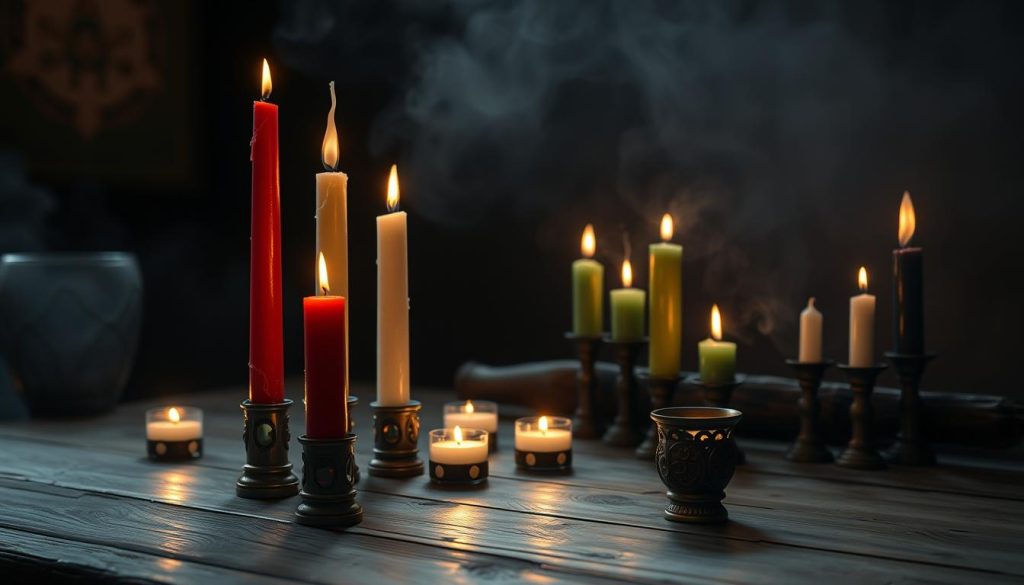You’ll learn a clear, practical way to bring intention into your magical practice while staying grounded in nature. This short guide shows what a spell is, how it differs from broader magic, and why focus and preparation matter for reliable results in daily life.
Almost anybody can cast with the right steps. You get a simple roadmap that builds confidence step by step. We cover ethics, core tools, timing, and the parts of the process you’ll practice to protect your boundaries and respect others.
You’ll also see beginner-friendly examples for protection and self-love that fit busy schedules across the United States. Track your progress, honor free will, and use patience—results often unfold over time. This is an easy way to begin a thoughtful, long-term practice without overwhelm.
Key Takeaways
- Understand the difference between a spell and general magic, and why nature matters.
- Follow a step-by-step process to build confidence and skill.
- Learn essential ethics, tools, and simple, safe workings for protection and self-care.
- Respect free will and focus on intention to keep practice responsible.
- Use tracking and patience to align spell work with life goals.
Wicca spells: what they are and how they work today
A well-ordered ritual gives you a reliable way to focus energy and move toward a chosen outcome. A spell is a ritual or set of actions designed to channel natural forces toward a clear goal, often using candles, herbs, and crystals to amplify intent.
Witchcraft refers to the broader craft of working with magic and natural power. Wicca is a nature-centered path where rituals tap universal power to manifest positive change in daily life.
You will often weave the four elements—earth, air, fire, water—into practice to balance the energy you raise. Simple or complex forms work, as long as your intention is clear and your steps follow an intentional order.
Journaling, meditation, and visualization strengthen focus before a spell. After the ritual, release the outcome and continue aligned action in the mundane world; the ritual supports, not replaces, real-life effort.
Ethics, intention, and alignment with nature
Clear ethical boundaries make your ritual work safer, more focused, and more effective. The Wiccan Rede—”An ye harm none, do what ye will”—serves as a simple guide for choosing words and actions that minimize harm. Use it to weigh consent and consequences before you act.
The Rule of Three asks you to consider how the energy you send returns to you. Treat this as an ethical compass: positive intent often yields constructive results while careless power can complicate your path.
The Wiccan Rede and the Rule of Three
Use journaling, brief meditation, and visualization to sharpen your intention. These focus practices help your mind match your purpose and raise the vibration of your work.
Setting clear intentions without manipulating others
Phrase intentions in positive, present-tense language and avoid trying to control another person’s will. Favor protection that shields you or your space, and center love workings on consent-based outcomes.
Reflect after each ritual: note what you intended, what you did, and how results unfolded. Ethical alignment channels power more sustainably and improves long-term results.
Core tools and natural correspondences for effective spellwork
Your tools shape how effectively you can focus intention and direct energy.
Candles, herbs, and crystals: choosing materials with purpose
Choose candles by color and aim—green for prosperity, white for clarity, black for protection—so each candle reinforces your goal.
Select herbs for traditional correspondences, such as basil for abundance or rosemary for cleansing. Use them to dress a candle, add to a charm, or burn safely for scent and symbolism.
Work with crystals like clear quartz to amplify and program your intention. A single crystal or a small grid can act as a focal point when you need steady amplification.

Working with the four elements: earth, air, fire, and water
Map element meanings to your goal: earth for stability and growth, air for clarity and ideas, fire for transformation and drive, water for healing and emotion.
Invite one or more elements into your working to balance the energy and deepen correspondence between your materials and intent.
Creating sacred space: casting and closing the circle
Cleanse the area, visualize a protective boundary, and invite elemental energy to form a focused container for the work.
Raise energy through breathwork, movement, or quiet chanting, then direct that energy into your chosen candle or crystal.
Close the circle with clear thanks, release the boundary, and tidy the area. Keep surfaces stable, use fire-safe holders, and ventilate the room to stay safe.
Maintain your tools by cleansing herbs and crystals, trimming wicks, and storing ingredients carefully. Document what you used and why so you can repeat and refine what works over time.
Step-by-step: how to cast a spell from intention to release
Start each working by naming a clear outcome and arranging everything you need in a simple order. Clarify your intention, then list the ingredients and tools—candles, herbs, crystals—so you have an easy way to stay organized.
You prepare your mind with quick focus practices. Spend five minutes journaling or using breath-led visualization to settle your mind and align emotion with purpose.
Ritual preparation and materials
Set your space and cast a circle if that fits your practice. Arrange items in the order you will use them; this keeps each part clear and calm.
Focus practices: journaling, meditation, visualization
Write a short petition using precise words: state what you seek, why it matters, and a reasonable timeline. Use meditation or a vision board to strengthen the image before you begin.
Ritual actions: petitions, incantations, energy raising
Raise energy through breath, drumming, or chanting, then channel that energy into a candle or talisman. Speak your incantation clearly and trust your voice to move the energy where it belongs.
Closing, grounding, and letting results unfold
Close with thanks, ground by touching the floor or having a simple snack, and dismantle the setup safely for the day. Record sensations and any synchronicities so you can compare results next time.
Release the working instead of obsessing. Take practical steps in the mundane world to support the spell and review outcomes later to refine your process.
Simple spells for beginners you can try at home
Small, clear rituals help you learn structure, focus, and ethical intent. Below are three compact workings you can adapt to your space and schedule. Each uses easy ingredients and straightforward steps so you can practice safely and build confidence.
Protection spell bag to protect your home
Use a sturdy drawstring bag (black is traditional). Add spearmint, wintergreen, benzoin, frankincense, and a clear quartz. Speak sincere protective words over each ingredient and the bag, then seal it.
Place the bag near entry points or rooms where you want calmer energy. You can craft several small charms and move them as needed to protect home energy.
Three-candle self-love ritual
Light three candles in sequence. Say: “I am love. I am the loved and the lover. My love endures beginning with me.”
Relight the candle setup daily at a chosen time until they burn down. This steady practice reinforces healthy self-worth and inner balance.
Creativity sigil painting ritual
Cleanse brushes and canvas, then meditate on: “Everything I create is exactly what I am supposed to create.” Paint a personal sigil in black, let it dry, then glaze with red mixed with cedarwood oil.
Hang it in your workspace. Touch the piece and repeat your line of intent before sessions to anchor creative confidence.
Safety tip: Use fire-safe holders, ventilate when burning resins or oils, and dispose of remnants mindfully. Track what you try and note changes to refine your practice.
Timing your magick: lunar phases, seasons, and daily rhythm
Small timing choices—moon phase, hour, or sabbat—can shift how energy responds to your ritual. Use simple timing to let nature support your aim and boost the chance of clear results.

Moon phases and goals
Map the moon to intent: waxing for growth, full for culmination, waning for release, and new for seeding. A lunar calendar app helps you pick the best window and plan a series of quick workings.
Wheel of the Year and seasonal energy
Work with the eight Sabbats to match seasonal currents. Use seasonal symbolism and color to deepen the ritual’s vibration and link your practice to wider cycles.
Choose the right time of day
Match hour to aim: morning for new starts, afternoon for productivity, evening for reflection, night for inner work. Prepare your mind and clear your space with brief grounding before you begin.
Practice tip: keep a timing log and note which crystals and candles you used. Over months you’ll see patterns and refine when your magick and real-world actions combine for better results.
Enhancing your practice with modern tools and resources
Digital resources bring clarity and consistency to ritual work. You can use guides, trackers, and curated libraries to learn faster and avoid common mistakes. Many apps now combine a glossary, reference sections on herbs, candles, and crystals, plus timed planners for lunar phases.
Glossaries, guides, and beginner-friendly references
Start with a clear glossary so terms and correspondences make sense the moment you encounter them in a blog or book.
Use checklists to stock only essentials and to plan protection spells or prosperity work without overbuying. The app’s library offers templates for love, healing, and protection, and an AI practitioner gives personalized step suggestions you can adapt.
Using a lunar calendar and trackers to plan rituals
Schedule rituals with a lunar calendar and seasonal tracker to align timing with nature. Log results to spot patterns and refine your method over weeks.
Watch for a sale on supplies or trusted books so you can build a compact home kit. Consider talismanic earrings or a small altar bag with a candle, a crystal, and a few herbs for travel and daily wear.
Tip: keep app support info and privacy links handy so your practice stays secure and supported.
From protection to prosperity: aligning spells with purpose
Define your purpose before you pick materials, timing, or wording. Start by naming the life goal you want to support so each ritual serves a clear aim.
Choose a category—protection, prosperity, love, or healing—then match tools and timing to that purpose. Protection work can use a candle, a small bag charm, and crystals to shield a person or home without projecting harm.
For love, center self-love and ethical attraction. Avoid coercion and state the qualities you want instead of trying to control people.
Prosperity work pairs energetic focus with real actions like budgeting, applying, and networking. Magic and practical steps together make the result more likely.
Keep healing rituals supportive of medical care and aim energy toward balance and resilience. Cleanse between categories and choose uplifting words to tune vibration so energies don’t mix.
Adapt things you already own, watch for a sale when you need supplies, and track timing, tools, and results. Refine your actions over time to build a sustainable witchcraft practice that protects home and advances your goals.
Conclusion
A compact method—clarify, prepare, cast, raise energy, close, and release—keeps your work steady and repeatable.
You leave with a clear way to practice that pairs ritual with daily action so results unfold over time. Commit to ethical, wiccan principles that protect consent and community.
Start small as beginners: use a candle, a crystal, and a few herbs in a tidy space at home. Plan sessions by day and season, and add tools only when you find a good sale.
Track what you try so each spell and charm improves in order and strength. Balance witchcraft study with practical steps, stay patient in love and prosperity work, and keep learning as your magick grows.